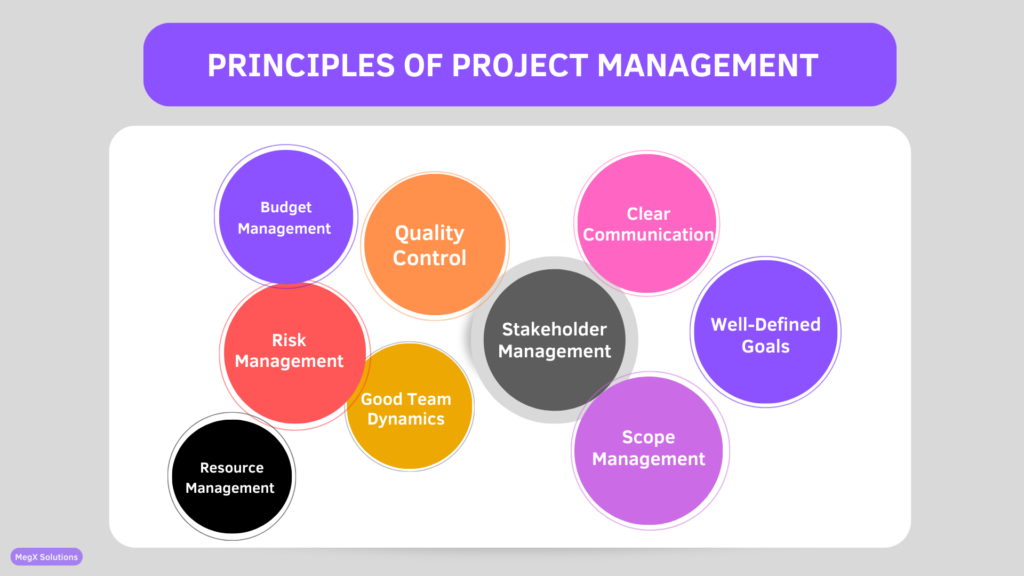
Mastering the Principles of Project Management: Your Guide to Success
Welcome to the world of project management, where the art of planning, executing, and closing projects comes to life! Whether you’re a seasoned project manager or just starting out, understanding the core principles of project management is essential for delivering successful projects. Let’s dive into these principles and explore how they can guide you to project success.
1. Project Integration Management
Integration management is all about ensuring that various elements of a project are properly coordinated. It involves making trade-offs among competing objectives and alternatives to meet or exceed stakeholder expectations. Think of it as the glue that holds the project together.
Project Charter: Develop a project charter that formally authorises the project and provides the project manager with the authority to apply organisational resources.
Project Plan Development: Create a comprehensive project management plan that outlines how the project will be executed, monitored, and controlled.
Project Plan Execution: Direct and manage project work to ensure that the project stays on track.
Integrated Change Control: Manage changes to the project scope, schedule, and costs in a coordinated way.
2. Project Scope Management
Scope management involves defining and controlling what is and is not included in the project. It ensures that the project includes all the work required to complete it successfully.
Scope Planning: Develop a scope management plan that outlines how the project scope will be defined, validated, and controlled.
Scope Definition: Create a detailed project scope statement that includes project deliverables, and the work required to create them.
Work Breakdown Structure (WBS): Break down the project deliverables into smaller, manageable components.
Scope Verification: Ensure that the completed project deliverables meet the defined scope.
Scope Control: Monitor the project scope and manage changes to the scope baseline.
3. Project Time Management
Time management is about planning and controlling the schedule to ensure that the project is completed on time.
Activity Definition: Identify the specific activities that need to be performed to produce the project deliverables.
Activity Sequencing: Determine the order in which activities need to be performed.
Activity Duration Estimating: Estimate the amount of time each activity will take.
Schedule Development: Create a project schedule that outlines when each activity will be performed.
Schedule Control: Monitor the project schedule and manage changes to the schedule baseline.
4. Project Cost Management
Cost management involves planning, estimating, budgeting, and controlling costs to ensure that the project can be completed within the approved budget.
Cost Estimating: Develop an approximation of the costs of the resources needed to complete the project.
Cost Budgeting: Aggregate the estimated costs of individual activities to establish a cost baseline.
Cost Control: Monitor project costs and manage changes to the cost baseline.

5. Project Quality Management
Quality management ensures that the project will satisfy the needs for which it was undertaken. It involves both quality assurance (processes) and quality control (deliverables).
Quality Planning: Identify quality requirements and standards for the project and its deliverables.
Quality Assurance: Implement processes to ensure that the project will meet the quality standards.
Quality Control: Monitor and record results of quality activities to assess performance and recommend necessary changes.
6. Project Human Resource Management
Human resource management is about organising, managing, and leading the project team.
Human Resource Planning: Identify and document project roles, responsibilities, and reporting relationships.
Acquiring the Project Team: Obtain the human resources needed to complete the project.
Developing the Project Team: Improve the competencies and interaction of team members to enhance project performance.
Managing the Project Team: Track team member performance, provide feedback, resolve issues, and manage changes to optimise project performance.
7. Project Communications Management
Communications management involves ensuring timely and appropriate generation, collection, dissemination, storage, and disposition of project information.
Communications Planning: Determine the information and communications needs of the project stakeholders.
Information Distribution: Make needed information available to project stakeholders in a timely manner.
Performance Reporting: Collect and distribute performance information, including status reports, progress measurements, and forecasts.
Managing Stakeholder Expectations: Engage stakeholders and manage their expectations through effective communication.
8. Project Risk Management
Risk management involves identifying, analysing, and responding to project risks to minimise their impact on the project.
Risk Management Planning: Decide how to approach and plan risk management activities for the project.
Risk Identification: Determine which risks might affect the project and document their characteristics.
Qualitative Risk Analysis: Prioritise risks based on their probability and impact.
Quantitative Risk Analysis: Numerically analyse the effect of identified risks on overall project objectives.
Risk Response Planning: Develop options and actions to enhance opportunities and reduce threats to project objectives.
Risk Monitoring and Control: Track identified risks, monitor residual risks, identify new risks, and evaluate risk process effectiveness.
9. Project Procurement Management
Procurement management involves acquiring goods and services from outside the organisation to meet project requirements.
Procurement Planning: Determine what to procure, when, and how.
Solicitation Planning: Document product requirements and identify potential sources.
Solicitation: Obtain quotations, bids, offers, or proposals as appropriate.
Source Selection: Choose from among potential sellers.
Contract Administration: Manage the relationship with the seller.
Contract Closure: Complete and settle each contract, including resolution of any open items.
10. Project Stakeholder Management
Stakeholder management involves identifying all people or organisations affected by the project, analysing stakeholder expectations, and developing appropriate strategies for effectively engaging stakeholders in project decisions and execution.
Stakeholder Identification: Identify all stakeholders and understand their interests, expectations, and influence.
Stakeholder Analysis: Assess how stakeholders are likely to react or respond in various situations.
Stakeholder Engagement Planning: Develop strategies to effectively engage stakeholders throughout the project lifecycle.
Stakeholder Engagement: Communicate and work with stakeholders to meet their needs and address issues as they occur.
Stakeholder Monitoring: Monitor stakeholder engagement and adjust strategies as needed.
Wrapping up the Principles of Project Management
Mastering the principles of project management is essential for delivering successful projects. By understanding and applying these principles, you can ensure that your projects are well-planned, efficiently executed, and effectively controlled. Whether you’re managing a small project or a large, complex initiative, these principles provide a solid foundation for achieving your project goals.
So, gather your team, set your goals, and embark on your project management journey with confidence. With these principles as your guide, you’re well on your way to project success!
I hope this helps you understand the core principles of project management and how to apply them effectively. Happy project managing!
Management, Planning, Principles, Project Management, Stakeholders
Author
Recent post

25 November 2024

14 March 2023

14 March 2023

14 March 2023

14 March 2023

14 March 2023